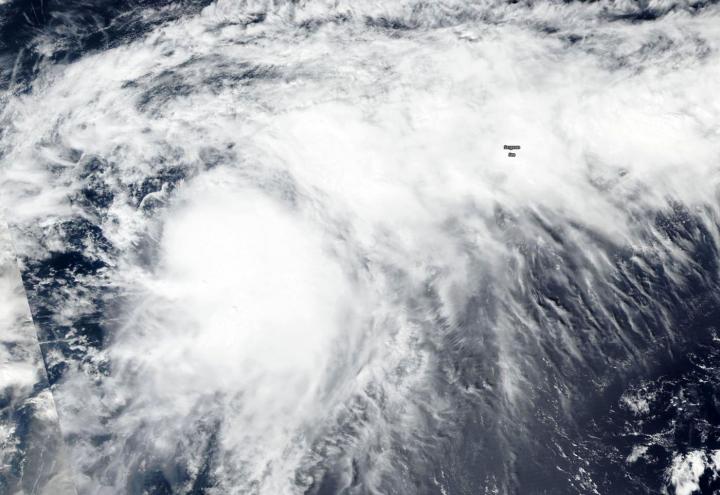
Credit: Credit: NASA Worldview, Earth Observing System Data and Information System (EOSDIS)
Forecasters use a variety of satellite imagery to understand what’s happening in a storm, and sometimes just a visible picture can tell a lot. NASA-NOAA’s Suomi NPP satellite provided forecasters with a visible image of the storm that showed wind shear was pushing clouds away from the storm’s center.
The shape of a tropical cyclone provides forecasters with an idea of its organization and strength. When outside winds batter a storm it can change the shape of it and push much of the associated clouds and rain to one side of it. That’s what wind shear does.
In general, wind shear is a measure of how the speed and direction of winds change with altitude. Tropical cyclones are like rotating cylinders of winds. Each level needs to be stacked on top each other vertically in order for the storm to maintain strength or intensify. Wind shear occurs when winds at different levels of the atmosphere push against the rotating cylinder of winds, weakening the rotation by pushing it apart at different levels.
Visible imagery from NASA satellites help forecasters understand if a storm is organizing or weakening, or if it is being affected by vertical wind shear. The Visible Infrared Imaging Radiometer Suite (VIIRS) instrument aboard Suomi NPP provided a visible image of Jerry on Sept. 22. The image showed the bulk of clouds associated with Jerry were pushed to the east-northeast, indicating a west-southwesterly wind shear.
NOAA’s National Hurricane Center or NHC noted that wind shear was affecting the storm on Monday, September 23, 2019. NHC noted that strong winds shear associated with an upper atmospheric, elongated low pressure area located off the southeastern U.S. coast continues to affect Jerry. That system is creating winds from the west-southwest that are pushing the bulk of Jerry’s clouds and showers to the east-northeast.
On Monday, September 23, 2019, NOAA’s National Hurricane Center issued a tropical storm warning for Bermuda.
At 11 a.m. EDT (1500 UTC), NHC reported the center of Tropical Storm Jerry was located near latitude 28.1 degrees north and longitude 68.0 degrees west. Jerry is about 345 miles (560 km) Southwest of Bermuda. Jerry is moving toward the north-northwest near 7 mph (11 kph), and this general motion should continue today. Maximum sustained winds are near 65 mph (100 kph) with higher gusts. Gradual weakening is expected during the next few days. The estimated minimum central pressure is 991 millibars.
A turn to the north is expected tonight followed by a turn to the northeast on Tuesday. On the forecast track, the center of Jerry is expected to pass near Bermuda by Tuesday night or early Wednesday. Jerry is expected to produce 1 to 3 inches of rainfall across Bermuda through Wednesday. Swells generated by Jerry are beginning to increase along the coast of Bermuda, and they will continue to affect the island during the next few days.
Hurricanes are the most powerful weather event on Earth. NASA’s expertise in space and scientific exploration contributes to essential services provided to the American people by other federal agencies, such as hurricane weather forecasting.
For updated forecasts. visit: http://www.
###
Media Contact
Rob Gutro
[email protected]
Original Source
https:/




